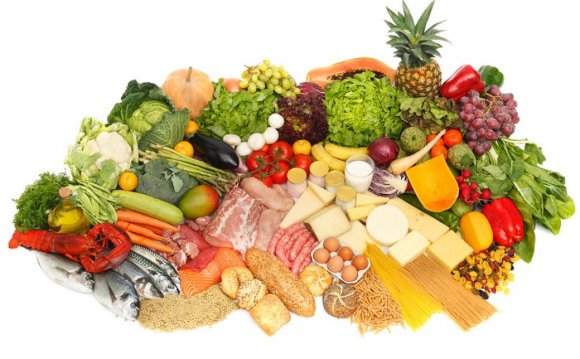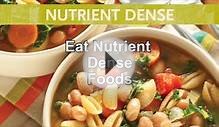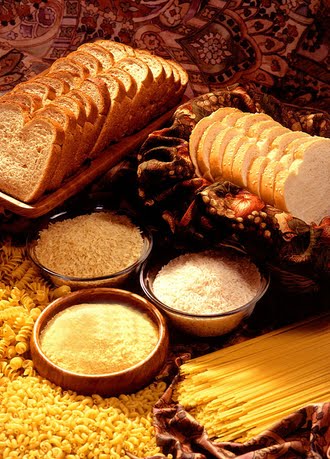
| Instead of this: | Try this: |
| Croissants, biscuits, white breads and rolls | Low-fat whole grain breads and rolls (wheat, rye and pumpernickel) |
| Doughnuts, pastries and scones | English muffins and small whole grain bagels |
| Fried tortillas | Soft tortillas (corn or whole wheat) |
| Sugar cereals and regular granola | Oatmeal, low-fat granola and whole-grain cereal |
| Snack crackers | Crackers (animal, graham, rye, soda, saltine, oyster) |
| Potato or corn chips and buttered popcorn | Pretzels (unsalted) and popcorn (unbuttered) |
| White pasta | Whole-wheat pasta |
| White rice | Brown rice or wild rice
|
| Fried rice, or pasta and rice mixes that contain high-fat sauces | Rice or pasta (without egg yolk) with vegetable sauces |
| All-purpose white flour | Whole-wheat flour |
Fruits and Vegetables
Fruits and vegetables are naturally low in fat. They add flavor and variety to your diet. They also contain fiber, vitamins and minerals.
Margarine, butter, mayonnaise and sour cream add fat to vegetables and fruits. Try using nonfat or low-fat versions of these foods. You can also use nonfat or low-fat yogurt, low-fat salad dressing, or herbs as seasonings instead.
| Instead of this: | Try this: |
| Fried vegetables or vegetables served with cream, cheese or butter sauces | All vegetables raw, steamed, broiled, baked or tossed with a very small amount of olive oil and salt and pepper |
| Coconut | Fruit (fresh) |
| French fries, hash browns and potato chips | Baked white or sweet potatoes |
Meat, Poultry and Fish
Beef, Pork, Veal and Lamb
Baking, broiling and roasting are the healthiest ways to prepare meat. Lean cuts can be pan-broiled or stir-fried. Use either a nonstick pan or nonstick spray coating instead of butter or margarine.
Trim outside fat before cooking. Trim any inside, separable fat before eating. Select low-fat, lean cuts of meat. Lean beef and veal cuts have the word "loin" or "round" in their names. Lean pork cuts have the word "loin" or "leg" in their names.
Use herbs, spices, fresh vegetables and nonfat marinades to season meat. Avoid high-fat sauces and gravies.
Poultry
Baking, broiling and roasting are the healthiest ways to prepare poultry. Skinless poultry can be pan-broiled or stir-fried. Use either a nonstick pan or nonstick spray coating instead of butter or margarine.
Remove skin and visible fat before cooking. Chicken breasts are a good choice because they are low in fat and high in protein. Use domestic goose and duck only once in a while because both are high in fat.
Fish
Poaching, steaming, baking and broiling are the healthiest ways to prepare fish. Fresh fish should have a clear color, a moist look, a clean smell and firm, springy flesh. If good-quality fresh fish isn't available, buy frozen fish. Try to eat seafood twice a week.
Most seafood is high in healthy polyunsaturated fat. Omega-3 fatty acids are also found in some fatty fish, such as salmon and cold-water trout. They may help lower the risk of heart disease in some people.
Cross-over Foods
Dry beans, peas and lentils offer protein and fiber without the cholesterol and fat of meats. Once in a while, try substituting beans for meat in a favorite recipe, such as lasagna or chili.
TVP, or textured vegetable protein, is widely available in many foods. Vegetarian "hot dogs, " "hamburger" and "chicken nuggets" are low-fat, cholesterol-free alternatives to meat.
| Regular or breaded fish sticks or cakes, fish canned in oil, seafood prepared with butter or served in high-fat sauce | Fish (fresh, frozen, canned in water), low-fat fish sticks or cakes and shellfish (such as shrimp) |
| Prime and marbled cuts | Select-grade lean beef (round, sirloin and loin) |
| Pork spare ribs and bacon | Lean pork (tenderloin and loin chop) and turkey bacon |
| Regular ground beef | Lean or extra-lean ground beef, ground chicken and turkey breast |
| Lunch meats such as pepperoni, salami, bologna and liverwurst | Lean lunch meats such as turkey, chicken and ham |
| Regular hot dogs or sausage | Fat-free hot dogs and turkey dogs |
Dairy
Choose skim milk or low-fat buttermilk. Substitute evaporated skim milk for cream in recipes for soups, sauces and coffee.
Try low-fat cheeses. Skim ricotta can replace cream cheese on a bagel or in a vegetable dip. Use part-skim cheeses in recipes. Use 1% cottage cheese for salads and cooking. String cheese is a low-fat, high-calcium snack option.
Plain nonfat yogurt can replace sour cream in many recipes. (To maintain texture, stir 1 tablespoon of cornstarch into each cup of yogurt that you use in cooking.) Try mixing frozen nonfat or low-fat yogurt with fruit for dessert.
Skim sherbet is an alternative to ice cream. Soft-serve and regular ice creams are also lower in fat than premium styles.
| Instead of this: | Try this: |
| Whole or 2% milk | Non-fat or 1% milk |
| Evaporated milk | Evaporated non-fat milk |
| Regular buttermilk | Buttermilk made from non-fat (or 1%) milk |
| Yogurt made with whole milk | Nonfat or low-fat yogurt |
| Regular cheese (examples: American, blue, Brie, cheddar, Colby and Parmesan) | Low-fat cheese with less than 3 grams of fat per serving (example: natural cheese, processed cheese and nondairy cheese such as soy cheese) |
| Regular cottage cheese | Low-fat, nonfat, and dry-curd cottage cheese with less than 2% fat |
| Regular cream cheese | Low-fat cream cheese (no more than 3 grams of fat per ounce) |
| Regular ice cream | Sorbet, sherbet and nonfat or low-fat ice cream (no more than 3 grams of fat per 1/2 cup serving) |
Fats, Oils and Sweets
Eating too many high-fat foods not only adds excess calories (which can lead to obesity and weight gain), but can increase your risk factor for several diseases. Heart disease, diabetes, certain types of cancer and osteoarthritis have all been linked to diets too high in fat. If you consume too much saturated and trans fats, you are more likely to develop high cholesterol and coronary artery disease.
Sugar-sweetened drinks, such as fruit juice, fruit drinks, regular soft drinks, sports drinks, energy drinks, sweetened or flavored milk and sweetened iced tea can add lots of sugar and calories to your diet. But staying hydrated is important for good health. Substitute water, zero-calorie flavored water, non-fat or reduced-fat milk, unsweetened tea or diet soda for sugary drinks. Talk with your family doctor or a dietitian if you have questions about your diet or healthy eating for your family.
| Cookies | Fig bars, gingersnaps and molasses cookies |
| Shortening, butter or margarine | Olive, soybean and canola oils |
| Regular mayonnaise | Nonfat or light mayonnaise |
| Regular salad dressing | Nonfat or light salad dressing |
| Using fat (including butter) to grease pan | Nonstick cooking spray |
INTERESTING VIDEO




 Human nutrition is the provision to obtain the materials necessary to support life. In general, people can survive for two to eight weeks without food, depending on stored body fat and muscle mass. Survival without water is usually limited to three or four days...
Human nutrition is the provision to obtain the materials necessary to support life. In general, people can survive for two to eight weeks without food, depending on stored body fat and muscle mass. Survival without water is usually limited to three or four days...








